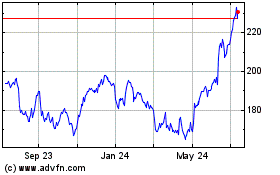Stock Futures Signal Muted Rebound After Tech Selloff
September 04 2020 - 7:55AM
Dow Jones News
By Joe Wallace
U.S. stock futures wobbled Friday, signaling that parts of the
market may extend losses after a burst of volatility in highflying
technology stocks prompted the biggest tumble in the S&P 500 in
almost three months.
Futures tied to the S&P 500 wavered between gains and
losses. The broad market gauge on Thursday dropped 3.5% in its
biggest retreat since June 11, leaving the S&P 500 on track for
its first weekly loss in six weeks.
Nasdaq Composite futures slid 1%, suggesting the tech-heavy
index could come under further pressure after tumbling 5% on
Thursday. The gauge's one-day point decline was its largest in
almost six months.
The tech sector's selloff was driven by a retreat in many of the
companies that drove the rally in U.S. stocks in recent months. A
record $180 billion was erased from Apple Inc.'s market valuation
on Thursday after the stock dropped 8%. That is the most that any
American company has ever lost in a single day. Despite the rout,
Apple's stock is up 65% this year. The shares ticked down 1.8% in
premarket trading.
Investors are gauging an incomplete economic recovery and
reassessing valuations that had decoupled from corporate
fundamentals, according to Samy Chaar, chief economist at Lombard
Odier.
"In the past few weeks, there's been a big trade on newer
technology that wasn't built on a lot," Mr. Chaar said. "We saw the
worst of the [economic] shock. But what I would add to that is that
we've seen the best of the recovery."
The Cboe Volatility Index, a gauge of expected swings in the
S&P 500, slipped 1.3 points. On Thursday, the so-called Vix
jumped seven points, its biggest one-day advance since June.
The bout of volatility is unlikely to be the start of a
downtrend, in part because institutional investors still have
further room to boost their exposure to stocks, said Sophie Huynh,
cross-asset strategist at Société Générale. "For now I think the
selloff could be fairly limited," she said.
Attention is likely to focus sharply on the monthly report on
the U.S. labor market, due at 8:30 a.m. ET, for evidence on the
pace of the economic rebound. Hiring likely eased in August from a
faster pace earlier this summer, a sign the economy is settling in
for a slow recovery from the shock of the coronavirus pandemic.
Economists expect employers to have added about 1.3 million jobs
in August, a solid monthly payroll gain but the smallest in four
months. State reopenings helped boost employment by a combined 7.5
million payrolls in May and June before hiring growth slowed in
July.
"It's a partial and incomplete recovery so far," said Agnès
Belaisch, chief European strategist at the Barings Investment
Institute. She is watching to see if the so-called participation
rate rises, which would indicate Americans who had stopped looking
for work are re-entering the workforce.
The yield on 10-year Treasury notes ticked up to 0.646%, from
0.621% Thursday, ahead of the jobs report. Yields rise as bond
prices fall. The WSJ Dollar Index, which tracks the U.S. currency
against a basket of others, was steady.
Prices for Brent crude rose 0.7% to $44.35 a barrel. That still
puts the international oil benchmark on course to lose 3.5% this
week. That would be its biggest weekly decline since mid-June. A
swift recovery in fuel consumption by U.S. drivers is petering out,
posing new challenges to the oil market, economy and energy
industry.
International markets were mixed. The Stoxx Europe 600 advanced
0.1%, led by shares in banks and travel-and-leisure companies.
In Asia, Japan's Nikkei 225 closed down 1.1%, South Korea's
Kospi Composite lost 1.2% and China's Shanghai Composite fell 0.9%.
Australia's S&P/ASX 200 fell nearly 3.1%, in its worst session
since the start of May.
The pullback in stocks bears similarities to an earlier
retrenchment in June, said Eli Lee, head of investment strategy at
Bank of Singapore. He doesn't see scope for a deep correction.
"In the longer term, low interest rates and the gradual recovery
in the global economy will be supportive for risk assets," said Mr.
Lee.
--Chong Koh Ping contributed to this article.
Write to Joe Wallace at Joe.Wallace@wsj.com
(END) Dow Jones Newswires
September 04, 2020 07:40 ET (11:40 GMT)
Copyright (c) 2020 Dow Jones & Company, Inc.
Apple (NASDAQ:AAPL)
Historical Stock Chart
From Mar 2024 to Apr 2024

Apple (NASDAQ:AAPL)
Historical Stock Chart
From Apr 2023 to Apr 2024
